The AHA’s Physician Alliance strives to make available resources to prepare today’s physician for tomorrow’s challenges. Building the next generation of care necessitates close collaboration between clinicians and administrators across the care continuum. With rapid changes in care delivery, high performing leadership teams are needed to combine high quality and high efficiency to deliver high value care. Below are examples of work accomplished toward achieving this aim, of developing leaders necessary to promote excellence in patient care.
AHA-AMGA Learning Collaborative: Better Care Integration In an Era of Uncertainty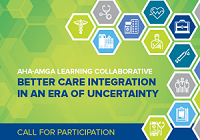
The American Hospital Association (AHA) and AMGA are pleased to announce a call for participation for AHA or AMGA members to join a learning collaborative on developing and advancing clinical enterprises in an uncertain and dynamic environment for hospitals, health systems, and medical groups. As a current AHA or AMGA member, your organization is eligible for this exclusive program. The AHA-AMGA Learning Collaborative is a national-level comprehensive program that addresses critical success factors such as leadership, culture, infrastructure, resilience and well-being, execution, alignment, reimbursement, and physician compensation. This program builds on the successful program conducted in 2016-2017. The collaborative will begin in February 2019 and end in June 2020. Learn more.
Verification of Graduate Medical Education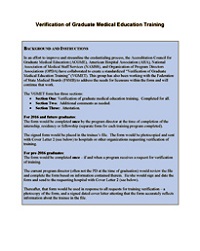
To help streamline and standardize the residency verification process and meet hospital credentialing needs, the AHA, in partnership with other national organizations, has developed a template letter and form that would provide the necessary information to meet credentialing needs while reducing the need for program directors to complete multiple requests for information.
AHA – AMA: New Guiding Principles on Integrated Leadership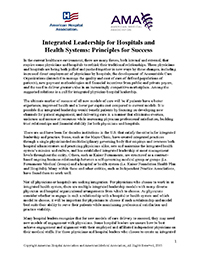
The American Hospital Association (AHA), American Medical Association (AMA) and Health Affairs convened a dialogue among leading health policy experts and representatives from 10 innovative integrated delivery systems in October 2013 to expand the discussion on how care will be organized in the future to meet the goals of a more effective system. In follow up, in October 2014, the AHA and AMA held a smaller working group discussion to further develop the criteria to drive effective and successful new models of care based on integrated leadership.
Through these and further discussions, the AHA and AMA compiled six key principles for how this new relationship might be structured and maintained. The AHA shared the draft principles with its governance groups for input from the field. The revised principles were then approved by the boards of both the AHA and AMA.
Governance of Physician Organizations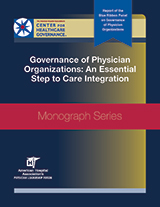
With the growth of health care organizations into larger and more complex care delivery systems, physician practices and other physician organizations are joining these systems and becoming critical collaborators and partners in their development. Physicians are assuming new clinical leadership and governance roles as part of care delivery transformation. Sharing their experiences and challenges in these roles is the focus of Governance of Physician Organizations: An Essential Step to Care Integration.
Innovative Models of Care Delivery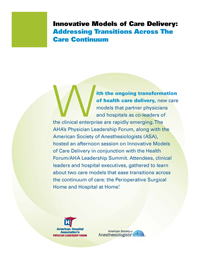
With the ongoing transformation of health care delivery, care models which partner physicians and hospitals as co-leaders of the clinical enterprise are rapidly emerging. More than 100 physician and hospital executives gathered for this half-day complimentary program to learn about two care models that ease transitions across the continuum of care: the perioperative surgical home and the Hospital at Home®.
The program, a collaboration between the AHA’s Physician Alliance and the American Society of Anesthesiologists (ASA), highlighted real-world examples of innovative care delivery models. See below for the video shared by presenter Kathy Davis, RN, MBA, NEA-BC, of Presbyterian Healthcare Services featuring the Hospital at Home® model.
Continuing Medical Education as a Strategic Resource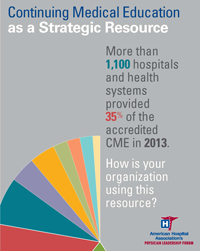
A new report from the AHA’s Physician Alliance recommends ways to improve the value of continuing medical education to hospitals. Hospitals provided 35% of the accredited CME in 2013, investing close to $1 billion. “CME allows physicians to reach their full potential both as caregivers and leaders of the health care field,” said AHA Senior Vice President John Combes, MD. “We have an opportunity to use CME strategically to achieve the goals not only of individual physicians but the entire delivery system to meet the needs of the patients and communities we serve.”
To improve the use of CME as a strategic resource for hospitals, the report recommends greater use of performance-based CME; more streamlined accreditation standards; broader sharing of best practices; increased communication between CME departments and senior leadership; and greater involvement of physician leaders as CME champions.
AMA – AHA Joint Leadership Conference on New Models of Care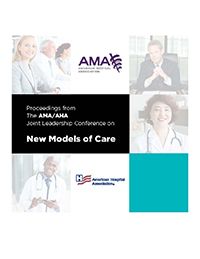
In October 2013, the American Medical Association (AMA) and the American Hospital Association (AHA) came together to convene a Joint Leadership Conference on New Models of Care in Washington, D.C. in collaboration with Health Affairs. This exclusive meeting brought together hospital and health system leaders, physician leaders, and government policymakers to expand the discussion on how care will be organized in the future to meet the goals of a more effective system.
The AMA – AHA Joint Leadership Conference focused on expanding the conversation of health care leaders and policymakers on the need for greater physician-hospital alignment to achieve the Triple Aim and move toward a reformed system. The proceedings published as a result of the conference outline the key takeaways and illustrate ten different examples of care models focusing on the financing, operations and cultural considerations.
Physician Leadership: The Implications for a Transformed Delivery System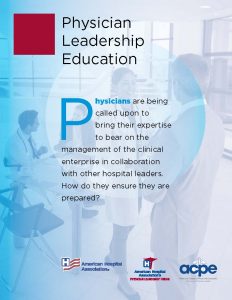
Together with the American College of Physician Executives, the PLF held a half-day session in July 2013 to better understand the changing landscape and the leadership competencies physicians will need to be effective partners with hospitals and health systems and move toward a more accountable and efficient health delivery system.
The PLF, as part of its focus to foster strong physician-hospital relations, has sought to identify and encourage leadership development opportunities for physicians. To that end, this report highlights the case for developing physician leaders, identifies characteristics to consider for leadership education programs, and concludes with the proceedings from the PLF’s educational summit.
Lifelong Learning: Physician Competency Development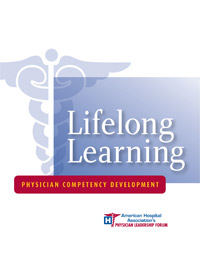
Based on the work of the Regional Policy Boards and the Advisory Group on Physician Competency Development the PLF developed recommendations to the field and published them as a white paper Lifelong Learning: Physician Competency Development in June 2012. An excerpt was published in the Journal of Graduate Medical Education in September 2012.
As part of the process, AHA, along with ACGME, convened a meeting of stakeholders in medical education and training to discuss ways we might collaborate to advance the competencies in the health care delivery system. The meeting included a roundtable of the efforts already underway at the invited organizations and an in-depth discussion of how to instill greater “systemness” in the education and training of physicians.
Creating the Hospital of the Future: Implications of Hospital-Focused Physician Practice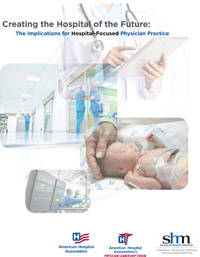
In conjunction with the Health Forum/AHA Leadership Summit in July 2012, the PLF, along with the Society for Hospital Medicine, hosted an interactive half-day session designed to explore how hospital-based medical practice is evolving to re-shape care delivery in the hospital of the future. The session included lessons learned from the first fifteen years of hospital medicine, a panel discussion with several specialty hospitalist groups including neurology, obstetrics, orthopedics, and acute care surgery, a view from the CEO perspective of the impact of hospital-focused practice on delivery of care and the bottom line, and how hospital-based practice can lead to better performance and safer hospital care.
Team-Based Health Care Delivery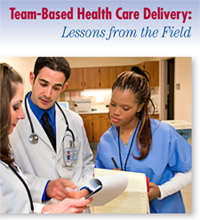
In follow up to the session on Achieving Team-Based Health Care Delivery at the Health Forum/AHA Leadership Summit in July 2011, the PLF published Team-Based Health Care Delivery: Lessons from the Field, highlighting the three case examples’ efforts to promote team-based care delivery:
- AtlantiCare Health System’s Special Care Center (SCC), a patient-centered medical home for individuals with chronic conditions, which has resulted in reduced hospital length of stay, readmissions, and ER visits.
- Brigham and Women’s Hospital’s Integrated Teaching Unit (ITU) which increased time for learning among residents, improved communication and collaboration among personnel, and reduced costs.
- Marquette General Health System’s transition from traditional medical departments to service lines which encompass a broad spectrum of medical and hospital staff to include all directly involved with a patient’s care.
